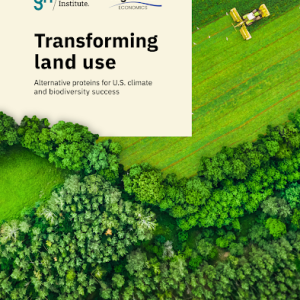
A report from the Good Food Institute, a thinktank for Alternative proteins, indicates that a shift toward alternative proteins in the US protein supply would enable a significant amount of land to be repurposed for agroecological and regenerative farming as well as for habitat restoration and conservation.
Publisher’s Summary
The USA has ambitious land conservation targets and climate goals that require reconnecting and restoring broad swaths of the American landscape. We can make significant progress in achieving these conservation goals by diversifying American protein sources to include land-efficient alternative proteins, specifically, plant-based, fermentation-derived, and cultivated proteins, while reducing the proportion of protein derived from land-intensive, animal-based foods. Incorporating alternative proteins into the American food supply significantly reduces U.S. land requirements for food production and would enable large-scale restoration of U.S. habitats with significant climate and biodiversity opportunities. A shift in land use would position the United States to reach its environmental and climate goals while continuing to be a global leader in agriculture and land stewardship.
This report quantifies the biodiversity and carbon sequestration opportunities of restoring U.S. croplands following a 50 percent shift from animal protein toward alternative proteins. Accounting for the land use efficiency of alternative proteins versus conventional animal protein, this report estimates the feed crop and forage cropland acreage available for restoration. Using two different strategies to prioritize land for restoration in each crop type, the analysis quantifies the biodiversity opportunity and the carbon sequestration opportunity of restoring cropland to the historical ecosystem that existed prior to Euro-American settlement. The analysis focuses exclusively on U.S. cropland demand to meet current (2023) U.S. protein consumption. As such, this report does not include the land restoration benefits associated with a) rangeland used for grazing livestock,1 b) cropland used for biofuels or export of animal feed or products, c) other resource uses such as water demand, or d) other environmental impacts of animal production systems such as direct greenhouse gas emissions. Therefore, the results presented herein are conservative estimates of the carbon sequestration and biodiversity benefits of increased land use efficiency resulting from alternative protein adoption.
Read more here. See also the TABLE explainer, Meat, metrics and mindsets: Exploring debates on the role of livestock and alternatives in diets and farming.












Post a new comment »